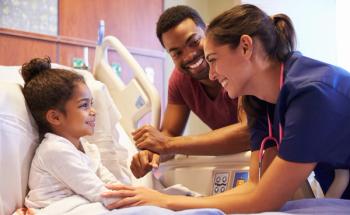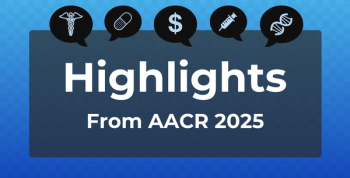
For Patients Who Cannot Wait, This Off-the-Shelf CAR NK Treatment for AML Leaves Healthy Cells Alone
Key Takeaways
- SENTI-202, an allogeneic CAR NK cell therapy, offers a pre-manufactured option for aggressive cancers like AML, overcoming delays associated with autologous CAR T-cell therapies.
- The therapy's unique "NOT Gate" mechanism targets cancer cells while sparing healthy cells, potentially reducing myelosuppression and other toxicities.
First part of a 2-part interview with Stephen Strickland, MD, MSCI, director of leukemia research for Sarah Cannon Research Institute. Strickland recently presented data from a phase 1 trial of SENTI-202, an investigational chimeric antigen receptor (CAR) natural killer (NK) cell therapy.
In some blood cancers, chimeric antigen receptor (CAR) T-cell therapy has been lifesaving. These treatments are engineered with patients’ own T cells to express a synthetic receptor, or CAR, that binds to antigens to set loose a powerful immune response. These treatments can destroy cancer or produce a prolonged response in pediatric leukemia, B-cell lymphoma, and multiple myeloma; for patients lacking options, CAR T can seem like a miracle.
But there’s a catch: The custom treatments can take up to 6 weeks to manufacture, and some patients cannot wait. For patients with fast-moving
For these patients, investigators have worked to create allogeneic, or “off-the-shelf” CAR treatments that could be manufactured ahead of time with healthy donor cells. At the recent meeting of the
Several patients experienced complete remission after treatment with SENTI-202, a first-in-class CAR natural killer (NK) cell therapy developed by
Results presented at AACR April 27, 2025, showed that 9 patients have received at least 1 dose of therapy, and 7 patients were evaluable for overall response. Additional data showed1-3:
- Patient 1 tested 2 doses and 2 schedules. Based on the data, a recommended phase 2 dose and schedule was 1.5 x 109 CAR NK cells administered on days 0, 7, and 14 in 28-day cycles after patients complete lymphodepleting chemotherapy.
- 2 of 3 patients achieved composite complete remission (cCR), and 5 of the 7 best overall response evaluable patients achieved an overall response, consisting of cCR plus a morphologic leukemia-free state, which means there are no longer leukemic blasts in the blood marrow. Of these patients, 4 of 7 achieved cCR, and 3 achieved CR with a full hematologic recovery; 1 had a CR with partial hematologic recovery.
- A maximum tolerated dose was not reached, and there were no dose-limiting toxicities.
To understand these data and for insights into how the CAR NK cell treatment works, The American Journal of Managed Care® (AJMC®) spoke with the study’s lead author, Stephen Strickland Jr, MD, MSCI, who is director of leukemia research for Sarah Cannon Research Institute (SCRI).
AJMC: Can you give an overview of how CAR NK cell therapy works and how it differs from the currently approved CAR T-cell therapies?
Strickland: There are several aspects that make this therapy somewhat unique. First, the cell of interest is a CAR NK, as opposed to a T cell. All of the commercially available products to date, in both the lymphoma space as well as the myeloma space, are autologous T-cell products. That requires apheresis, or collection from the patient, before these cells are shipped off for manufacturing and engineering. And that takes maybe 6 weeks or so for that product to be available for the patient.
Obviously, keeping cancer under control during that period or needing to get some bridging therapy is an issue that that we have run into many times, depending on how proliferative or aggressive their malignancy is.
This NK cell product is an allogeneic product; the cells come from a healthy donor and can be collected well in advance of the patient in need being identified. The cells go through this somewhat efficient process for the engineering of [the therapy]. The introduction of the engineering that's going to this gene circuit allows the cell to be educated and primed to hopefully go after 2 different markers on the leukemia cell. Then, those cells are expanded and then cryopreserved, and so they're on the proverbial shelf, ready and waiting when the patient in need is identified.
The engineering of the cell is different as well, compared with some of the currently available products, in the sense that the current products are for lymphoma and myeloma. We do not have an approved product for AML or for myeloid malignancies in general, but this CAR NK is actually engineered to recognize 2 markers. One is CD33, which is a known and validated marker for myeloid malignancy and AML in particular, but also for FLT3 expressing.
Now, you may have heard a lot about FLT3 mutations and FLT3 inhibitors, and that's a little bit different in that this isn't mutation specific. It's actually FLT3 expression specific. The thought is that leukemia stem cells can express FLT3, and so we're hopefully targeting the CD33—which is on many of the circulating blasts—but then also a marker, which can hopefully be on the leukemic stem cell to sort of get at the root of the problem and reduce the number of these leukemia stem cells. These are the cells that are giving rise to the acute leukemia that we're seeing.
It's a novel gating system, this OR gate: it can hit CD33 or FLT3, but also a NOT gate, and the NOT gate helps to protect healthy cells. One thing that we know with the validated target of CD33 is that other therapies which have targeted that in the past also can be myelosuppressive. And so normal hematopoietic cells may get caught in the crossfire, if you will. We do see myelosuppression, immune suppression, risk of infection, and need for transfusions as a result of targeting CD33 with some of these more conventional products. And so, this system was designed, hopefully, to protect the healthy hematopoietic stem cells and lead to less myelosuppression.
This NOT gate is for endomucin-expressing cells. Endomucin is a molecule that can be expressed on healthy hematopoietic cells, and when the cell senses endomucin, it will not attack the cell; it will not attack the cancer cell if it's expressing endomucin, even if it's also expressing CD33 and FLT3. So, it's this protective mechanism will hopefully spare the good cells.
AJMC: Are these CAR NK cells more robust and more effective than would be the case when using cells from a patient in an autologous process? In that case, by definition the treatment is made with cells from someone with cancer. Does this allogeneic aspect make a difference?
Strickland: Obviously, we haven't compared this head-to-head with [patient] donor-collected cells and healthy donor cells. But we believe [there is] an advantage in an off-the-shelf product. We know that cancer, in general, suppresses the host or the patient's own immune system, and by doing so, the cancer is allowed to evade the native immune system. And that suppression can happen in several different ways. But one of those ways is thought [to be] by suppressing the T-cell function, suppressing those cells’ ability to attack the cancer. By using healthy donor cells, we can get around that and make sure that we have a good, strong cellular product that isn't impacted by the things that led to the cancer evading the immune system in the first place.
AJMC: You had 9 patients in the data set that was presented at AACR, and you provided specific breakdowns for the various responses. Is there a general takeaway from the responses of these early patients? Have you treated additional patients—and if so, are there any overall trends?
Strickland: The study continues to move forward, and we are currently enrolling patients in a controlled manner. As you can imagine, as we've seen the responses, there's obviously a lot of excitement about this, and we're all trying to make this available for our patients at the sites that are participating. What we can say about the responses is that based on with the data that's been presented thus far, we have formal response evaluation in 7 of those 9 patients, and 4 of the 7 achieved a composite CR; 5 of the 7 have had responses with there being in the additional [patient] in a morphologic leukemia-free state. We’re seeing clearance of the blast cells—clearance of the leukemia cells. The big takeaway for us is that for the 4 patients among the first 7 had some level of a composite CR, these were MRD-negative CRs. So, this was [observed] not just morphologically under the microscope, but also by different methods—either next generation sequencing or flow cytometry—doing a deeper dive to [demonstrate] that there was no leukemia cell population that was detectable within the level of sensitivity of those tests.
We associate deeper responses with better overall prognosis and survival. This also provides options for patients, who can then potentially be [eligible for] an allogeneic stem cell transplant, and hopefully that will help to improve and enhance the opportunity for potential cure.
For the other 2 of those 9 patients, we don't have the final response assessment. That information is ongoing, because those patients were receiving a second cycle of the therapy [of 3 cycles] and will have a response assessment. But there was, as was reported, stable disease that occurred after 1 cycle, and then we're doing an additional cycle. It is not uncommon in AML therapy [to need] a second cycle of therapy in order to achieve a more formal response, hopefully a remission. That’s still in development; we have patients that are undergoing their response assessments even this week, so hopefully we'll have that data soon.
References
- Senti Bio’s SENTI-202, a first-in-class, off-the-shelf logic gated selective CD33 OR FLT3 NOT EMCN CAR NK cell therapy, demonstrates positive preliminary clinical results in the treatment of patients with R/R AML. News release. Senti Bio. April 27, 2025. Accessed April 28, 2025.
https://investors.sentibio.com/news-releases/news-release-details/senti-bios-senti-202-first-class-shelf-logic-gated-selective - Strickland S, Eghtedar A, Farhadfar N, et al. First-in-human multicenter study of SENTI-202, a CD33/FLT3 selective off-the-shelf logic gated CAR NK cell therapy in hematologic malignancies including AML: clinical data. Presented at: American Association for Cancer Research; April 25-30, 2025, Chicago, IL. Abstract CT014.
- Off-the-shelf natural killer cell therapy with logic gates elicits complete remissions in relapsed or refractory blood cancers. News release. American Association for Cancer Research. April 27, 2025. Accessed April 28, 2025.
https://www.aacr.org/about-the-aacr/newsroom/news-releases/off-the-shelf-car-natural-killer-cell-therapy-with-logic-gates-elicits-complete-remissions-in-relapsed-or-refractory-blood-cancers/
Newsletter
Stay ahead of policy, cost, and value—subscribe to AJMC for expert insights at the intersection of clinical care and health economics.









































